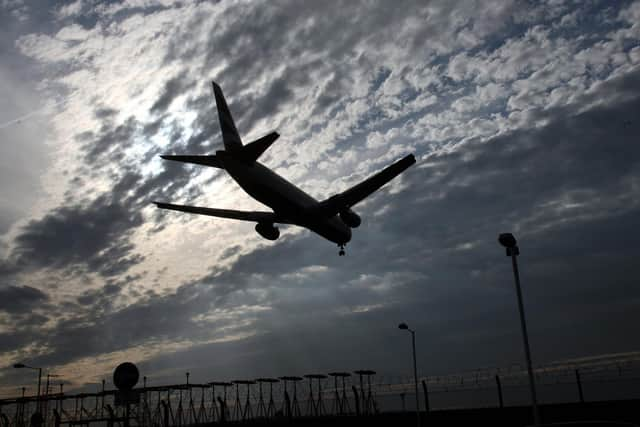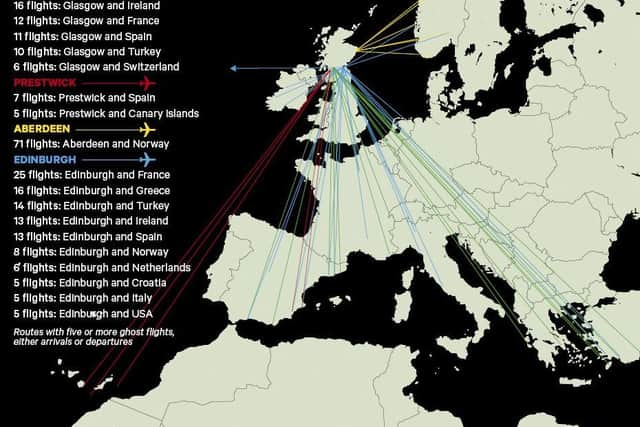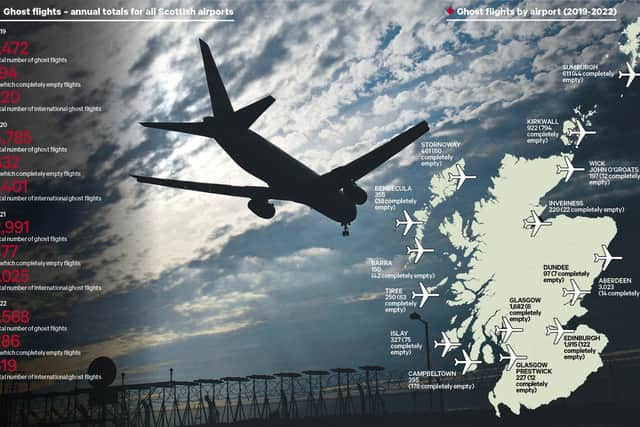More than 1,500 ‘ghost flights’ at Scottish airports last year as environmental 'damage' condemned
More than 1,500 empty or nearly empty passenger flights passed through Scotland’s airports last year, with the number of so-called ‘ghost flights’ rising sharply compared to before the coronavirus pandemic, an investigation by The Scotsman can reveal.
In what has been described as a “ludicrous” waste of resources that is inflicting “totally avoidable damage” on the environment, close to 300 flights, including multiple international journeys, departed or landed at Scottish airports without any passengers or cargo on board. They are among nearly 11,000 empty or nearly empty passenger flights at Scottish airports over the past four years.
Advertisement
Hide AdAdvertisement
Hide AdThe amount of completely empty flights has spiked by nearly 50 per cent compared to 2019, putting paid to the misconception the phenomenon would end once Covid-related international travel restrictions were removed. After the final restrictions were lifted in March last year, 998 ghost flights followed in the final nine months of the year, 186 of which were empty.
The trade body, Airlines UK, said only a “tiny fraction” of flights operated with few passengers or without any at all, and stressed airlines were “fully committed” to achieving net zero emissions by 2050. But at a time when the nation's airports are gearing up for their busiest time of the year, the extent of the polluting ghost traffic has sparked anger and concern over the climate impact and governmental inaction.
Aviation sources attributed the rise in ghost flights to a multitude of factors, including the impact of routes between Scotland and airports with ‘use-it-or-lose-it’ slot restrictions, as well as training, repositioning, and maintenance flights.
Commercial passenger services which flew empty last year included several departures from the Scottish Government-owned Prestwick Airport to the Canary Islands, a journey of around 2,000 miles. Multiple emissions-heavy transatlantic flights between the US and Edinburgh also flew with no passengers or cargo.
They are among a staggering 1,489 completely empty passenger flights that flew to or from Scottish airports between 2019 and 2022. While the number represents a fraction of the overall air transport movements – at Edinburgh alone, there were over 87,292 scheduled passenger flight air transport movements last year – the impact is significant. According to Dr Richard Dixon, the veteran environmental campaigner, the empty flights generated the equivalent emissions of around 6,000 extra cars on Scotland’s roads for a year.


A further 9,327 ghost flights – defined as services with fewer than 10 per cent of their seats filled – operated over the same period. Some 2,965 were international departures or arrivals. “The aviation industry likes to tell a story that it is getting on top of climate emissions by better management of flights, but these figures show that they are spectacularly failing, with hundreds of flights empty and thousands nearly empty, all of them wasting fuel and adding to climate change,” said Dr Dixon, a board member of Environmental Standards Scotland.
‘We need an urgent focus on cutting the number of flights’
While the vast majority of the empty or nearly flights were recorded during 2020 and 2021, when Covid-19 upturned the global aviation industry, the data shows the trend is intensifying compared with pre-pandemic levels.
During 2019, airlines operated 1,472 ghost flights in and out of Scottish airports, with 194 of them empty. In 2022, a year in which Scottish air travel only reached around 74 per cent of its 2019 levels, the total increased to 1,568, with 286 empty flights.


Advertisement
Hide AdAdvertisement
Hide AdAlthough airlines decide whether to operate such flights, the Scottish Government has been criticised for failing to tackle aviation emissions. In its most recent report to parliament, the Climate Change Committee said ministers’ commitment to growth in aviation demand “runs counter” to their own “very challenging emissions reduction targets”, and noted they had made “no commitments” to use devolved powers, such as airport expansion control and Air Departure Tax, to curb aviation growth.
Mark Ruskell, the environment, climate, and transport spokesman for the Scottish Greens, said: “How can we be at a stage when the world is burning yet there are flights taking off with nobody in them? It's a staggering waste of resources and is doing totally avoidable damage to our environment.
“We can't take the climate action that is so badly needed without curbing our dependency on aviation. We need an urgent focus on cutting the number of flights, particularly domestic flights where there is a rail alternative.”
Dr Doug Parr, chief scientist and policy director for Greenpeace UK, said: “The reason why ghost flights have increased is that the UK Government has failed to regulate to prevent them. However, the Scottish Government should have been well aware of what was going on at its airports, and should have sought to prevent or at least reduce the ghost flights either by direct engagement with the airlines or through getting better rules from the Civil Aviation Authority (CAA).”


Anna Hughes, director of Flight Free UK, a campaign group that urges people to pare back their air travel, also urged the administrations at Edinburgh and Westminster to take action. “Investing in rail and bus links would help people to travel in other ways, and raising fair taxation on aviation – for example, taxing jet fuel and introducing a frequent flyer levy – would ensure that aviation pays its way,” she said.
“Like the UK Government, Scottish politicians are relying on so-called sustainable aviation fuel, new technology and offsetting. None of these measures will reduce emissions fast enough or at the required scale to address the climate emergency that was declared by the Scottish Parliament in 2019.”
The airports with some of the highest ghost flight traffic
The Scotsman’s analysis of airport load factor data compiled by the CAA pinpoints airports with particularly high frequencies of ghost flight traffic. Between 2019 and 2022, there were 3,985 ghost flights across the 11 airports owned and operated by Highlands and Islands Airports Limited (HIAL), a public corporation wholly owned by Scottish ministers. A total of 1,335 of those flights were completely empty. There were 701 ghost flights last year, up from 522 in 2019. HIAL’s Kirkwall airport in Orkney saw the highest proportion of empty flights, with 181 ghost flights last year, and 922 between 2019 and 2022. 794 of those flights were empty.
The aviation industry consultant, John Strickland, said it was not necessarily surprising that certain regional routes had low load factors. “Some public service obligation (PSO) routes are social services,” he reasoned. “Airlines would like these flights to be as full as possible, but you can’t just sell all the seats on a small aircraft for £20. The economics of small aircraft do not support this. If you’re lucky, the load factors on these regional routes will be 50 per cent or 60 per cent.”
Advertisement
Hide AdAdvertisement
Hide AdA HIAL spokeswoman said: “HIAL’s airports are a critical element of the Scottish transport network. They support essential and lifeline services and facilitate air connectivity that is vital for some of our country’s more remote and island communities.”
Some 501 ghost flights went through Aberdeen International Airport last year. While nearly half that total constituted oil rig flights, it included 204 domestic flights, and 77 international journeys. There have been 3,023 ghost flights at Aberdeen since 2019, including over 720 international flights.
At Glasgow Airport, the number of ghost flights increased during 2022 compared to 2019, with 212 such services, including 93 international flights, such as multiple departures to the US, Spain and Germany. A spokesman for AGS Airports, which owns and operates Glasgow and Aberdeen airports, said: “It is important to understand that airlines operate flights and not the airport.”
The UK aviation regulator’s data also shows there were 151 ghost flights in and out of Edinburgh Airport in 2022, more than double the 75 in 2019. A total of 128 were international departures or arrivals, with several flights between the capital and the US, Hungary and Lithuania carrying no passengers or cargo. Since 2019, there have been 1,915 ghost flights, with the majority occurring during the pandemic; in the third quarter of 2020, there were a remarkable 169 ghost flights between Edinburgh and airports in France and Spain.
At Prestwick, 20 ghost flights were recorded last year, including two empty outgoing passenger flights to the Canary Islands, and an empty arrival from Spain. Since 2019, there have been 227 empty or nearly empty flights.
The South Ayrshire airport said nearly two thirds of those flights took place at the start or end of seasonal timetables. The remainder were predominantly a mixture of positioning flights – many of which occurred during the COP26 climate change summit, when multiple aircraft flew from Glasgow Airport to Prestwick – as well as training flights, diverted or unscheduled departures, and Covid-19 recovery flights. There were 12 completely empty flights to and from Prestwick over the four years, although the airport, home to one of Ryanair’s largest maintenance bases, said all were for maintenance reasons.
‘Slot’ rules cited as one of several reasons behind empty air traffic
There is no consensus as to reasons for the frequency of ghost flights. While some airlines previously cited the need to use passenger flights to transport medical supplies during the pandemic, the CAA data shows that in 2020, there were no cargo-only passenger flights to or from any Scottish airports. In 2021, the figure was just 42; all those flights were departures from Aberdeen to oil rigs.
Mr Strickland, pointed to numerous factors for ghost flights, such as aircraft required to position empty to maintenance bases, flying in replacements for aircraft with mechanical problems, and late running aircraft having to divert due to airport night closures or poor weather, and then positioning back empty later to the correct airport. “Smaller aircraft, such as those operated by Loganair, operate to airports with regular weather conditions such as high winds, causing the need to divert,” he said.
Advertisement
Hide AdAdvertisement
Hide AdTim Johnson, director of the Aviation Environment Federation (AEF), an environmental non-profit, said: “The pandemic was used to explain why flights could have been taking off empty to repatriate citizens stuck abroad after travel restrictions were imposed, or to transfer urgent medical supplies. But those explanations are no longer valid, and the research identifies an increase in pre-pandemic numbers.”
Several aviation sources cited air traffic between Scottish airports and what are known as ‘slot-co-ordinated’ airports, such as Heathrow, Stansted and Gatwick, as a contributory factor. The system guarantees airlines permission to take off and land at specific times to manage limited capacity, with some slots changing hands for £60m.
However, the framework has been widely criticised for encouraging airlines to run empty or low occupancy flights, often at a loss, to retain slots. The AEF believes ghost flights are such “an obvious example of wastage” that “the need for slot reform can’t be ignored”.
Although the slot rules were suspended for much of the pandemic, they were reintroduced at a 50:50 ratio for winter 2021/22, before being raised to 70:30 last summer, and 80:20 this summer, meaning airlines need to use take-off slots 80 per cent of the time to keep them. One source said the change could result in more ghost flights going through Scottish airports, especially after the UK Government halved air passenger duty (APD) on domestic flights.
Ms Hughes said that reforming landing slot rules to reduce the frequency of ghost flights would be an “easy win” in terms of shrinking aviation emissions. But Mr Strickland said in the event of a shortage of slots at full airports, any cut in airport capacity could jeopardise the operation of some regional routes, given airlines will be making decisions on a “purely commercial basis”, and would normally prioritise larger aircraft on routes with more passengers. “You’re always trying to plan routes efficiently, to avoid empty flights and poor performance, because it’s difficult to make money in this industry,” he explained.
Airlines ‘fully committed’ to net zero
Those eager to end the scourge of ghost flights say action is required not just by airlines, but governments. Finlay Asher, a mechanical engineer from Dumfries who is part of the team at Safe Landing, a coalition of aviation workers campaigning for reduced emissions, said policy should encourage flights with high load factors, and better regulate private jets and air miles schemes which incentivise frequent flying and premium, low capacity factor seat layouts. Mr Johnson pointed out passengers, not empty seats, were subjected to APD taxes. “This research suggests it's time to introduce penalties for inefficiency too,” he suggested.
Dr Parr added: “The aviation industry is incentivised to grow, that requires them to emit more carbon, and any pretence that they will decarbonise without being forced to do so is no more than a dishonest delaying tactic. The important thing to remember in all this is that the governments are very well aware of this, and every day they fail to fix the problem is another permit to pollute.”
British Airways said it did not operate ghost flights, while Ryanair said it operated a “small number of training flights” during the pandemic, which had “multiple crew members” on board. Loganair, EasyJet and TUI did not respond to enquiries from The Scotsman.
Advertisement
Hide AdAdvertisement
Hide AdIn a statement, Airlines UK said: “Millions of flights arrived and departed the UK between 2019 and 2022, with only a tiny fraction operating without or with few passengers and for a variety of operational reasons driven by the pandemic. 2022 was still a pandemic year for aviation as the sector was only able to begin reopening in the spring.
“UK airlines are fully committed to achieving net zero emissions by 2050, whilst getting our customers where they want to go. Alongside filling our flights as much as possible, we are making ‘jet zero’ a reality by modernising our airspace to further reduce inefficiencies, using at least 10 per cent sustainable aviation fuel by 2030 and driving the development of zero emission commercial aircraft.”
A spokeswoman for the Department for Transport said: “Though airlines may occasionally need to operate flights with lower passenger loads – for example to train pilots – we’re committed to avoiding unnecessary flights, while working with industry to reduce emissions more widely as part of our jet zero strategy.”
A spokesman for Transport Scotland said: “The regulation of air services is reserved to the UK Government. Many air services in Scotland serve remote and island destinations where air transport is essential in keeping communities connected. By their nature, some of these services, as with any mode of transport, can operate with very low passenger numbers, but the provision of the service can be vital for the individuals involved, especially those travelling for medical purposes.
“Good connectivity is key to achieving sustainable economic growth in Scotland. It enables flows of trade, investment, labour, knowledge and tourism visitors, which benefits Scotland’s economy as a whole. We are committed to working with Scotland's airports to help restore and grow our connectivity, while not returning to previous levels of emissions.”
The spokesman added: “Sustainable aviation fuels (SAF) could significantly reduce emissions from aviation and we welcome the commitments from industry and governments around the world to increase the use of SAF. While powers to introduce a SAF mandate and certification are reserved to the UK Government, we are considering how the Scottish Government might encourage airlines flying to and within Scotland to use SAF as part of our work to develop an aviation strategy.”
Comments
Want to join the conversation? Please or to comment on this article.